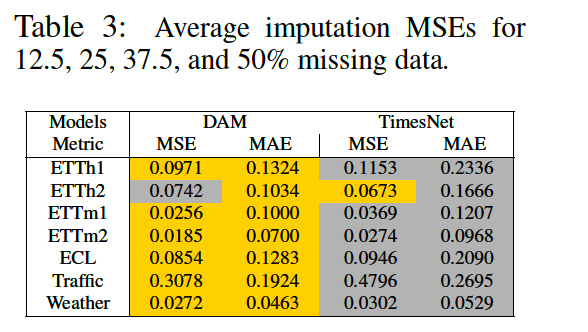DAM: Towards A Foundation Model for Time Series Forecasting (ICLR, 2024 (?))
Contents
- Abstract
- Introduction
- Related Work
- The DAM, explained
- Experiments
Abstract
Universal forecating
- TS with multiple distinct domains & different underlying collection procedures
Existing methods: assume “regularity”
- (1) input data is regularly sampled
- (2) forecast pre-determined horizon
\(\rightarrow\) failure to generalize!
DAM
- Input: randomly sampled histories
- Output: adjustable basis composition ( as a continuous function of time )
- Non-fixed horizon
- 3 components
- (1) flexible approach for using randomly sampled histories from a long-tail distn
- Q1) 멀리있더라도, 도움이 되는 정보가 있을 수 있지 않을까? ( = seasonality )
- (2) transformer backbone
- Q2) CNN, MLP는?
- (3) basis coefficients of a continuous fujnction of a time
- (1) flexible approach for using randomly sampled histories from a long-tail distn
Experiment
Single univariate DAM trained on 25 TS datasets
- SOTA across multivariate LTSF across 18 datasets
- 8 held-out for zero-shot
- robust to missing & irregularly sampled data
1. Introduction
Previous SOTA methods: FIXED-length common-interval sequences ( = regular TS )
\(\rightarrow\) does not scale well for many practical applications
\(\rightarrow\) we need more generaliezd forecasting methods!
Why does existing methods fail to generalize outside the scope of their training?
-
(1) assume INPUT data is FIXED-length & REGULARLY sampled
( = evenly spaced & ordered )
-
(2) assume pre-determined forecasting horizon
\(\rightarrow\) need to relax these assumptions for universal forecasting
Universal forecasting
- (1) must be robust to underlying collection processes
- (2) must be robust to cross-domain differences
DAM (Deep data-dependent Approximate analytical Model)
= foundation model for TS for universal forecasting
- (1) takes in randomly sampled histories
- (2) outputs time-function forecasts
- (3) use transformer backbone
2. Related Work
PatchTST/Dlinear/N-HiTS..
Multi-scale modeling
- (1) TimesNet & MICN
- use multi-scale mechanism, breaking the task up into multiple scales where CNN can operate
- (2) Pyraformer & Crossformer
- use custom hierarchical attention
- (3) LightTS
- applies down sampling an MLP to model at multiple scales
- (4) DAM
- use basis function composition
- can also access the distant past due to historical sampling regime
Frequency-domain modeling
- (1) Autoformer
- autocorrelation-based attention
- (2) Fedformer
- frequency domain enables global perspective
- uses frequency enhanced block & Fourier projeiction
- (3) FiLM
- uses Legrende polynomials & Fourier projections
- (4) ETSFormer
- uses 2 attention mechanisms that use ..
- a) exponential decay to explicitly bias toward recent history
- b) high amplitude fourier components
- uses 2 attention mechanisms that use ..
- (5) DAM
- operates in both frequency & time domains
3. The DAM, explained
DAM = single model for multiple Ts datastes across domains
- (1) Backbone: Transformer
- (2) Input: Historical Sampling Regime (HSR)
- ingest context data sampled from long-tail distn
- (3) Output: coefficients of basis functions
- define the shape of a continuous function of time, \(f(t)\)
(1) Backbone
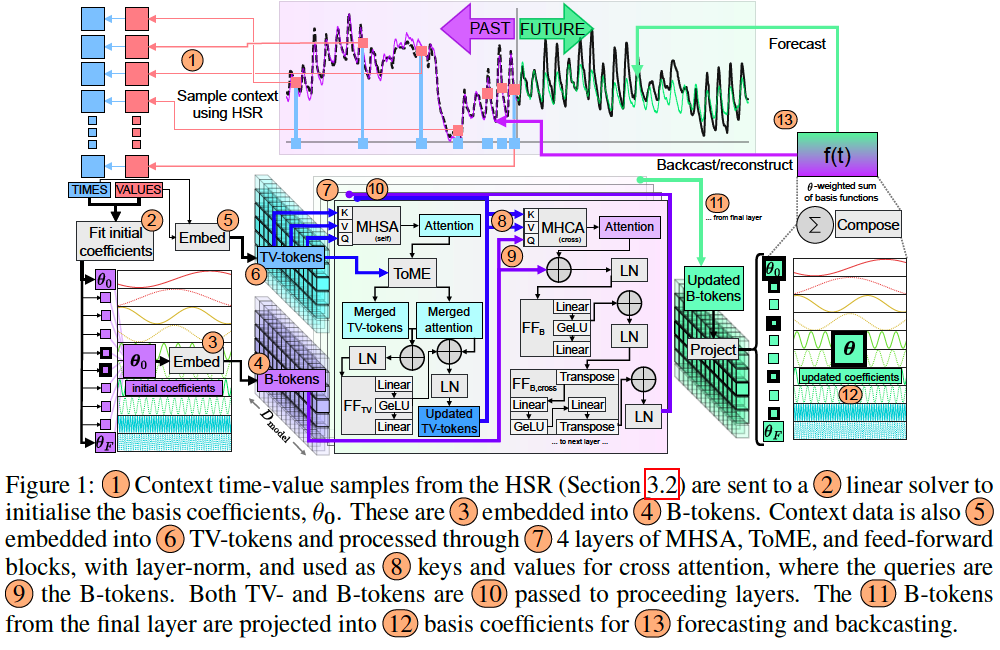
- \(D_{\text {model }}\) : latent dimension
- Input
- (1) univariate (time-value) tuple + with time units of day
- sampled from HSR
- (i.e., \(\delta t=1\) is a 1 day interval),
- (2) initialised basis coefficients + with corresponding frequency information
- (1) univariate (time-value) tuple + with time units of day
- Tokens
- (1) (time-value) tuple \(\rightarrow\) TV-tokens
- (2) initialised Basis coefficients \(\rightarrow\) B-tokens
- (3) Affine token: initialised with 50 evenly-spaced percentiles of the values for affine adjustments.
Model Structure
4 layers of processing, where each layer consists of …
- 4 heads of multi-head self-attention (MHSA) for TV-tokens
- 4 heads of cross-attention for B-tokens
- Q = B-tokens
- K & V = TV-tokens
- 3 separate feed-forward blocks for
- TV-tokens
- Affine token
- B-tokens
- Additional feed-forward block acting across B-tokens
- Multiple layer normalization (LN) layers
- Token merging
- used to reduce the number of TV-tokens during each layer of processing.
Other details:
- Simple compared to earlier methods!
- ( uses standard MHSA, not a time series-specific variant )
- Data need not be regularly sampled to yield continuous ‘blocks’
- No explicit multi-scale mechanisms are required
(2) Historical Sampling Regime (HSR)

Input: irregular and variable-length data
\(\rightarrow\) making it suitable to a broader variety of TS datasets & domains
\(\rightarrow\) can be trained easily on a large collection of TS datasets
( & miitigating early overfitting common in TS forecasting )
Uses a long-tail distribution over time steps
- \(x = t/R\), where \(R\) is the sample resolution (e.g., hourly)
- call this the history sampling regime (HSR)
- \(p_{\mathrm{hsr}}(x)=\frac{1}{c} \cdot \frac{1}{1+\frac{x}{\sigma}^2}\).
- \(c\) : normalisation constant
- \(\mathrm{X}\) : sample support
- \(\sigma\) : HSR ‘width’
- smaller \(\sigma\) biases sampling recent past more than distant past.
- used to sample \(x\), from which \((t, v)\) tuples are built, where \(v\) is the value at time \(t\).
- used for both
- context data from the past \((x<0)\)
- target data (any \(x\)).
- number of points: *variable
- \(p_{\mathrm{hsr}}(x)=\frac{1}{c} \cdot \frac{1}{1+\frac{x}{\sigma}^2}\).
Figure 2
- HSR-based context : gives access to a more global perspective
- Distribution: icreases the likelihood of sampling the distant past
- enabling a global perspective of the signal
- still ensure that the majority of samples are recent.
(3) Basis Function Composition
Select 437 frequencies
- 1 minute (1/1440 days) ~ 10 years(52x7x10 days)
- range: minute / hour / day /week year
- enable wide basis function coverage
Basis function composition
\(f(t, \boldsymbol{\theta}, \boldsymbol{\nu})=\operatorname{IQR}\left(a\left(\sum_{\nu=\frac{1}{1440}}^{52 \cdot 7 \cdot 10} \theta_{\nu, 1} \sin (2 \pi \nu t)+\theta_{\nu, 2} \cos (2 \pi \nu t)\right)-b\right)+M E D\).
- \(\theta\) : output vector from the DAM ( = basis function coefficients )
- \(\nu \in \mathbf{\nu}\) : frequency
- \(\theta_{\nu, 1}\) and \(\theta_{\nu, 2}\), : coefficients for sine and cosine functions at frequency \(\nu\)
- MED & IQR: Median and inter-quartile range per-datum
- for online robust standardisation
- \(a\) & \(b\) : affine adjustments
- also output from the DAM
Previous methods vs. DAM
- (previous) leverage basis functions that use some form of implicit basis
- (i.e., within the model structure)
- (DAM) use explicit composition
- 2 major advantages:
- (1) no fixed horizon and can be assessed for any \(t\)
- (2) basis functions are naturally interpretable
- 2 major advantages:
Basis function initialisation.
Advantageous to initialise B-tokens with basis coefficients fit to the context
- use a linear differential equation solver to find initialisation coefficients, \(\boldsymbol{\theta}_0\).

(4) Training
Loss function: Huber loss
- both RECONSTRUCT & FORECAST loss
Number of context points sampled from the HSR for context and targets : 540
\(\sigma\) : 720 during training
Before aggregation, the loss was re-scaled element-wise using an exponential decay of \(2^{-x / 360}\)
Train SINGLE DAM on 25 time series datasets
Iterations: 1,050,000
(5) Inference
Needs only (time-value) pairs from a given variable
Procedures
- (1) extract time-value pairs
- using the HSR probability defined over \(x\)
- sample indices using a weighted random choice (w/o replacement)
- (2) compute \(\boldsymbol{\theta}_0\) from context
- \(\boldsymbol{\theta}_0\) is input to the model and not one of the model parameters
- (3) forward pass to produce \(\boldsymbol{\theta}\)
- (4) compute basis composition at \(t\) or any other query times
Adopt channel-independence
HSR tuning
Significant advantage: iits settings (context size and \(\sigma\) ) can be set after training for better forecasting.
- estimate MSE per-dataset for a range of context sizes and \(\sigma\)
- Section 4.1 shows our results with and without this tuning
4. Experiments
33 datasets for training and evaluation
Training
- Augment 10 commonly used datasets
- split into train/valid/test
- 15 datasets are additionally used to enhance training
Evaluation
- 10 datasets : within-dataset generalisation
- ETTh1, h2, m1, and m2; ECL; Traffic; Weather; USWeather; Exchange; and Wind
- 8 held-out datasets : Illness, Weekdays, UCIPower, Azure, MTemp, MWeb, MWeather, and MMeters
(1) Long-term TS Forecasting
- Average of 3 seeds
-
6 SOTA methods
- DAM HSR-tuned : used optimal HSR values based on validation set performance
- Baselines : specialise on dataset-horizon combinations
- each baseline required 40 unique variants ( \(\leftrightarrow\) one model for DAM )
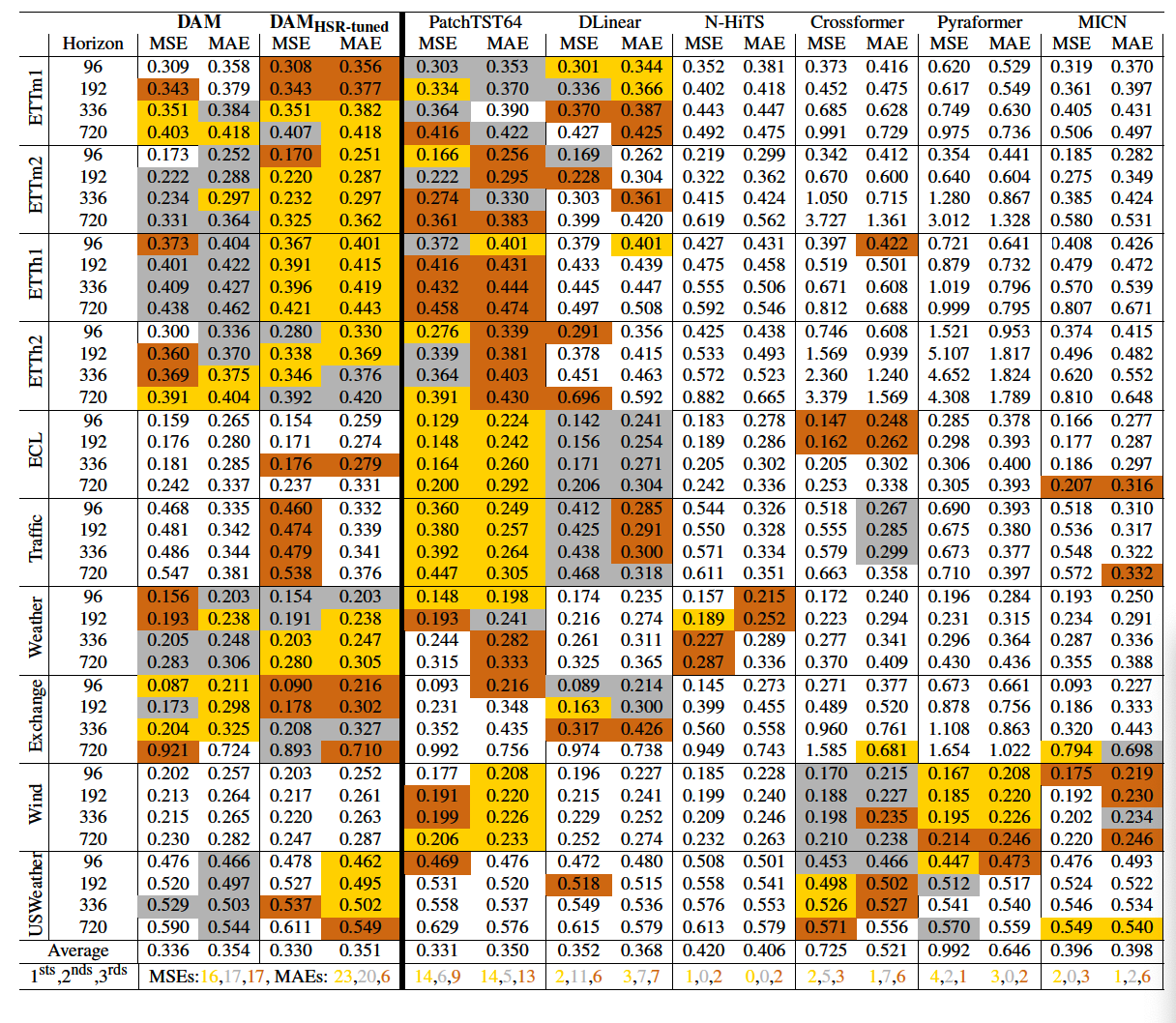
(2) Forecasting on Held Out Datasets
Foundation model
- should transfer well within scope but outside of its training datasets
- either under..
- fine-tuning
- zero-shot
- tested both protocols on 8 datasets held out datasets
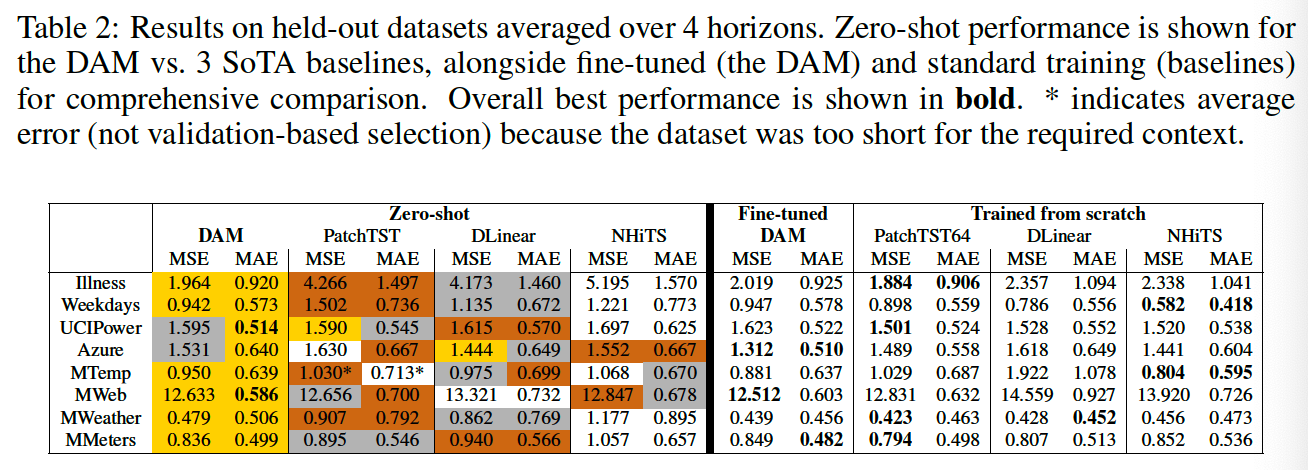
(3) VERY long-term forecasting
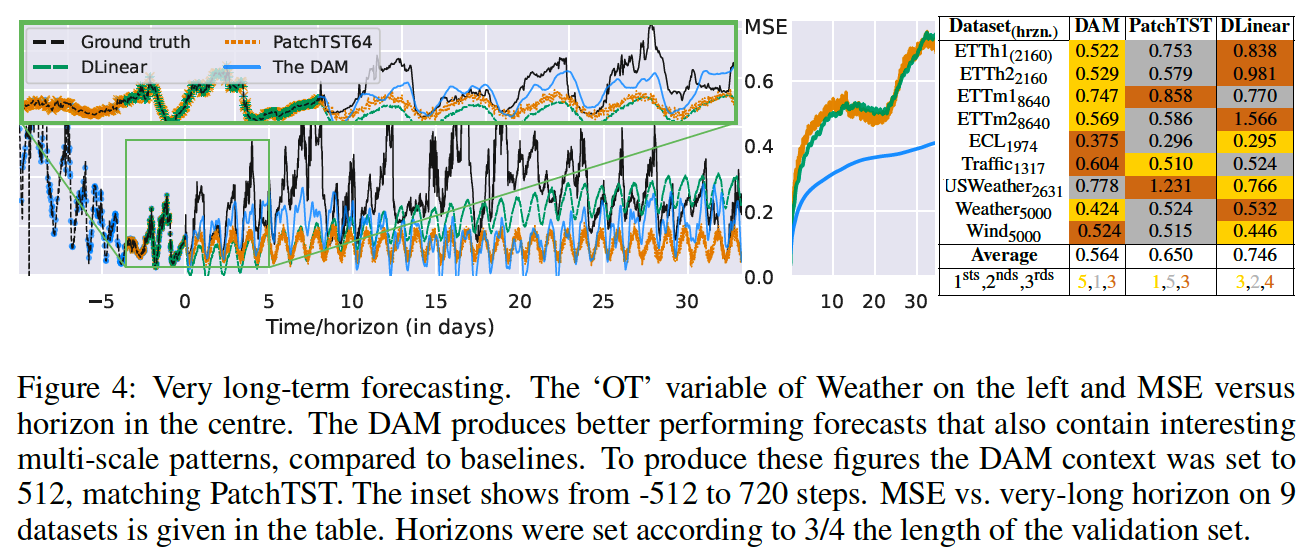
(4) Held out task: Imputation
TimesNet: SoTA on imputation task
No training of the backbone is even required in this case because the initialisation coefficients are optimal for past data.
